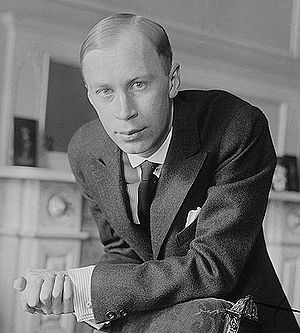Sergey Prokofiev (1891-1953)
Born April 23, 1891 in Sontsovka, Ukraine.
Died March 5, 1953 in Moscow.
“Classical” Symphony No. 1 in D Major, Op. 25
Composed:1916-1917.
First Performance: April 21, 1918 in Saint Petersburg (then called Petrograd) with Prokofiev conducting the Former Court Orchestra.
Instrumentation: 2 flutes, 2 oboes, 2 clarinets, 2 bassoons, 2 horns, 2 trumpets, timpani, strings.
Duration: ~ 15 minutes.
Prokofiev received his early training as a pianist and composer from his mother who was a pianist. He began composing at age 5 and wrote an opera The Giant when he was only 9. Later Prokofiev took private lessons from Reinhold Glière. In 1904 when he was only 13 he entered the Saint Petersburg conservatory. At this time he had already composed four operas, one symphony, two sonatas, and many piano pieces. He studied with Liadov, Rimsky-Korsakov, and Tcherepnin. He graduated from the Conservatory in 1914, winning the Anton Rubinstein prize for best student pianist. His work spanned all of the large scale genres, including seven symphonies, 5 piano concertos, 2 violin concertos, a cello concerto, film music, operas, ballets as well as chamber music and piano works including 9 piano sonatas. He left Russia in 1918 spending years in Paris and the Alps. He toured the United States five times. He returned to the Soviet Union permanently in 1936. He died in Moscow on March 5, 1953 within hours of Stalin’s death.
Prokofiev began composing his first symphony in 1916, completing the Gavotte first and then sketching the first and second movements. He spent the summer of 1917 alone in the country near Petrograd. He composed the symphony in his head during walks. He wrote that “I deliberately did not take my piano with me, for I wished to try composing without it. Until this time I had always composed at the piano, but I noticed that thematic material composed without the piano was often better.” Only a few years earlier he acquired something of an avant-garde reputation with works such as his Scythian Suite. So what motivated him to write this symphony in the classical style? He certainly had the necessary background having learned Haydn and the Classical style well at the conservatory under Nikolai Tcherepnin. We get some insight from his autobiography where he wrote “I seemed to me that had Haydn had lived to our day he would have retained his own style while accepting something of the new at the same time. That was the kind of symphony I wanted to write, a symphony in classical style. And when I saw that my idea was beginning to work, I called it the ‘Classical Symphony’ .” Stravinsky began writing a series of Neoclassical works such as Pulcinella and Mavra in the 1920s. For Prokoviev this revisiting the past was much more limited. He described it as a passing phase for himself and characteristically described Stravinsky’s Neoclassical music as “Bach with wrong notes.”
There are four movements:
1. Allegro
2. Larghetto
3. Gavotte: non troppo allegro
4. Finale: Molto vivace
The first movement is the expected sonata allegro form. From the opening flourish we are in the classical world but it doesn’t take long before we begin to hear more of Prokofiev’s idioms than those of Haydn. There are two themes and a development section which reaches a fortissimo climax with the second theme. As a nod to Haydn’s penchant for surprises, the recapitulation begins in the wrong key – C major instead of the expected tonic D major. But the listener doesn’t have to wait long for D major abruptly appears a few measures later.
The second movement 3/4 Larghetto begins with an almost motionless soaring melody high in the violin’s stratosphere. But soon the bassoons and pizzicato strings lend a gentle forward motion towards a tutti before subsiding and returning to the mood of opening.
The third movement is not the expected 3/4 minuet nor scherzo. Instead he uses the gavotte which is a French baroque folk dance which has 4 beats to the measure. One feature is that phrases begin in the middle of the measure, on the third instead of the first beat. The original gavotte was an elegant courtly dance but here it is more rustic; a characteristic of Haydn too. In the trio we even hear a bagpipe like open fifth drone as in Haydn’s Symphony No. 88.
The current sonata allegro finale is the second one written by Prokofiev who was dissatisfied with the first version. He set for himself the arbitrary rule of avoiding minor chords completely which certainly contributes to its bright yet frenetic cheerfulness.
Remember that 1917 was the year of the Bolshevik Revolution and that Prokofiev came from the class which was threatened by the communist uprising. Perhaps Prokofiev who was courageously hiding from the turmoil in the country was at the same time making a bold statement with this symphony which looks back to the 18th century.
Resources
[amazon template=iframe image&asin=B0000041YW]
[amazon template=iframe image&asin=0486449505]

I was just looking at the date and it says up the top that Prokofiev died in 1853 – that’s meant to be 1953.
Thank you.